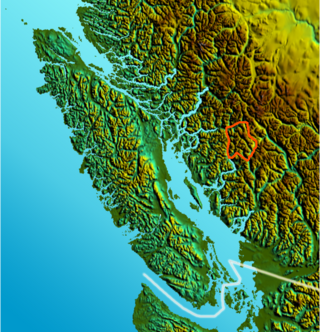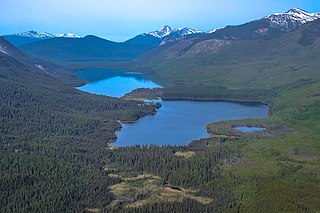Related Research Articles

The Wetʼsuwetʼen are a First Nation who live on the Bulkley River and around Burns Lake, Broman Lake, and François Lake in the northwestern Central Interior of British Columbia. The endonym Wetʼsuwetʼen means "People of the Wa Dzun Kwuh River ".

The Clendinning Range is a subrange of the Pacific Ranges of the Coast Mountains of British Columbia. About 1500 km2 in area and lies to the northwest of the better-known Tantalus Range near Squamish. Heavily glaciated and very rugged, with severe weather year-round, it is between the valleys of the Elaho River (east) and the Toba River (west).

Pimpirev Glacier on Livingston Island in the South Shetland Islands, Antarctica is situated south of the glacial divide between the Drake Passage and Bransfield Strait, southeast of Tundzha Glacier, southwest of Saedinenie Snowfield, west of Perunika Glacier and east-northeast of Kamchiya Glacier. The feature extends 5.5 km in a southeast-northwest direction, and 1.8 km in northwest-southeast direction. The glacier drains southeastwards towards Pimpirev Beach, mostly terminating on the shore, and on several occasions penetrating the South Bay waters east-northeast of Ereby Point.
Clendinning Provincial Park is a provincial park in British Columbia, Canada. It surrounds the drainage of Clendinning Creek, which is a tributary of the Elaho River. Its name is shared by the Clendinning Range, of which Mount Clendinning is the highest summit.

The Omineca Mountains, also known as "the Ominecas", are a group of remote mountain ranges in the Boreal Cordillera of north-central British Columbia, Canada. They are bounded by the Finlay River on the north, the Rocky Mountain Trench on the east, the Nation Lakes on the south, and the upper reaches of the Omineca River on the west. They form a section of the Continental Divide, that, in this region, separates water drainage between the Arctic and Pacific Oceans. The lower course of the Omineca River flows through the heart of the range. To the south of the Ominecas is the Nechako Plateau, to the west the Skeena Mountains and Hazelton Mountains, to the north the Spatsizi Plateau and the Stikine Ranges, while east across the Rocky Mountain Trench are the Muskwa Ranges.

The Gwa'Sala-Nakwaxda'xw Nations are a union of two Kwakwaka'wakw peoples in a band government based on northern Vancouver Island in British Columbia, Canada, whose main reserve community is near the town of Port Hardy in the Queen Charlotte Strait region of the Central Coast region of British Columbia, Canada. The band government is a member of the Kwakiutl District Council and, for treaty negotiation purposes, the Winalagalis Treaty Group which includes three other members of the Kwakiutl District Council.
The Lytton First Nation, a First Nations band government, has its headquarters at Lytton in the Fraser Canyon region of the Canadian province of British Columbia. While it is the largest of all Nlaka'pamux bands, unlike all other governments of the Nlaka'pamux (Thompson) people, it is not a member of any of the three Nlaka'pamux tribal councils, which are the Nicola Tribal Association, the Fraser Canyon Indian Administration and the Nlaka'pamux Nation Tribal Council.

The Sutton Range is a mountain range on Vancouver Island, British Columbia, Canada, located in the area between the headwaters of the Nimpkish River and those of the White River. It has an area of 448 km2 and is a subrange of the Vancouver Island Ranges which in turn form part of the Insular Mountains.
The Hogem Ranges are a group of mountain ranges in the northwest part of the Omineca Country of the North-Central Interior of British Columbia, Canada, located between Takla Lake (W) and the Omineca River (E) and from the Nation Lakes (SE) to the Sustut River (NW). The ranges have a collective area of 8868 km2 and is a subgrouping of the Omineca Mountains which in turn form part of the Interior Mountains.

The Kingcome Glacier is a glacier located at the head of the Kingcome River in southwestern British Columbia, Canada.
Sikanni is a variant spelling of Sekani, the name of an Athapaskan people of northern British Columbia, Canada. It is found in various placenames and related uses:
The Peak Range is a small subrange of the Swannell Ranges of the Omineca Mountains, located on the northwest side of the junction of Toodoggone River and Finlay River in northern British Columbia, Canada.
The Wrede Range is a small subrange of the Swannell Ranges of the Omineca Mountains, located between Ingenika River and Wrede Creek in northern British Columbia, Canada.
The Hartley Bay Indian Band is also known as the Gitga'at First Nation or the Hartley Bay First Nation. The members of the Gitga'at First nation are often referred to as Gitka'a'ata. The population of Gitk’a’ata peoples living in Hartley Bay ranges from approximately 130-200 people. There are also about 400-500 Gitk’a’ata peoples living in Prince Rupert, British Columbia, Canada, a neighboring territory. The Gitk’a’ata people have lived in Hartley Bay for hundreds of years, if not always. Some notable things regarding the Gitga'at First Nation are their economy, geography, government, sports involvement, COVID-19 regulations, and relations.

Fimbulheimen is a mountain range in Queen Maud Land, Antarctica. It stretches from Jutulstraumen by 1° west of Carsten Borchgrevink Ice at 18° east, about 200 km from the ice edge. Fimbulheimen is thus between Maudheim Plateau and Sør-Rondane.
Metsantan Pass, 1,270 metres (4,167 ft), is a mountain pass in the Metsantan Range of the Omineca Mountains in the Northern Interior of British Columbia, Canada. It is located between Metsantan Lake, in the drainage basin of the Stikine River (NW) and the headwaters of the Toodoggone River (SE), a tributary of the Finlay River which is part of the Peace-Mackenzie River drainage area, and therefore is located along the Continental Divide.
Yale First Nation is a First Nations government located at Yale, British Columbia. Yale has 16 distinct reserves stretching from near Sawmill Creek to American Creek, with the most southern reserve situated at Ruby Creek in the District of Kent.

Kalø Vig is a cove in the north end of the Bay of Aarhus, Denmark. It stretches in a semicircle from Skæring in the North West to Kalø Castle below Rønde in the North to the peninsula Skødshoved in the East. The area around Kalø Castle became a nature preserve in 1939 and is now a part of Mols Bjerge National Park. Sight lines over the cove from Hjelmager south of Løgten are subject to conservation and preservation rules.